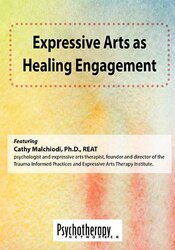

Expressive arts not only cultivate the healing powers of imagination, they also mobilize the social engagement system through play, improvisation, musicality, movement, and creativity. When integrated into therapy, they can revitalize and energize clients, helping them to engage more fully in the present while deepening implicit and meaningful sensory-based communications. In this hands-on recording, you’ll experience how to “get past talk” with creative, action-oriented methods that can be immediately applied to your practice.

Cathy A. Malchiodi, PhD, ATR-BC, LPCC, LPAT, REAT, is an expressive arts therapist and art therapist who has spent over 30 years working with individuals with traumatic stress and studying how the arts support reparation, integration and recovery from trauma. She is the founder and executive director of the Trauma-Informed Practices and Expressive Arts Therapy Institute that trains mental health and health care practitioners in medical, educational, and community settings and assists in disaster relief and humanitarian efforts throughout the world. Cathy has given more than 500 invited presentations in the US, Canada, Europe, Middle East, Asia and Australia and has published numerous articles, chapters, and more than 20 books, including Trauma and Expressive Arts Therapy: Brain, Body and Imagination in the Healing Process, Understanding Children’s Drawings, Handbook of Art Therapy, Creative Arts and Play Therapy for Attachment Problems, and Creative Interventions with Traumatized Children. She has received numerous awards for distinguished service, clinical contributions and lifetime achievements, including honors from the Kennedy Center and Very Special Arts in Washington, DC. A passionate advocate for the role of the arts in health, she is a contributing writer for Psychology Today Online with more than 5 million readers and a visual artist and occasional ukulele and Hulusi musician.
Speaker Disclosures:
Please wait ...